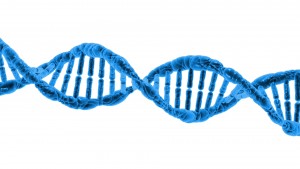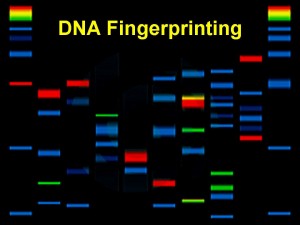By Christina Marvin

Crime dramas such as NCIS and Law and Order engross us with images of law enforcement blasting down city streets in pursuit of suspects, lights flashing and sirens blaring. Bringing criminals to justice often relies on the prompt ability to secure a crime scene and interview suspects. But what happens when criminals get away and years, even decades, pass? Over a third of all homicides in the United States remains unsolved – since 1980 that number translates into over 211,000 people, or roughly the population of Des Moines, Idaho.

Drawing faces from DNA
Investigators have long known the value of identifying suspects using DNA left at a crime scene. Until recently, the most useful analysis was to match DNA collected at crime scenes to DNA already on file through a process called DNA fingerprinting. An individual’s DNA “fingerprint” is unique, and investigators can use it to produce line patterns such as the one shown to the left. They then match the pattern with one on file. However, this technology is limited to identifying individuals who already have criminal records or are on file for some other reasons.
New technology is changing the way forensic scientists view DNA evidence, especially when extracting new information from DNA collected during cold cases. This year , DNA phenotyping produced a composite image of an unnamed suspect decades after the triple homicide of the Bennett family in Aurora, Colorado. On January 16, 1984, Bruce and Debra Bennett were killed in their home along with their 7-year-old daughter, Melissa. In spite of long hours of police work, the suspect remained a “ghost” for 32 years.
Thanks to DNA technology, this suspect now has a face.
Using only DNA collected at the crime scene, Parabon Nanolabs in Virginia produced a computer-generated sketch of what the suspect would have looked like in 1984 and what he could look like today using their new technology called Forensic DNA Phenotyping System (Snapshot). Last year, Parabon released an informative video, introducing this new technology, on Youtube:
https://www.youtube.com/watch?v=RGGXm8DMC3k&feature=youtu.be
Briefly, Snapshot creates a picture of an individual by predicting features such as ancestry, eye color, hair color, freckles, and face shape based only on information contained in his or her DNA. Snapshot does not produce an exact replica, but rather a scientific approximation. It is important to note that DNA can only predict genetic traits such as those mentioned. Environmental factors such as smoking, drinking, diet, facial hair, scarring, etc. generate effects that are totally unrelated to DNA. Nevertheless, Snapshot is effective enough that investigators now have an idea of what the Bennett family homicide suspect could look like for the first time in 32 years.
How DNA Phenotyping Works

Just as a contractor’s blueprint contains all of the information needed to construct a building, DNA contains all of the instructions needed to build a human being.
Snapshot relies on reading the genetic material in the DNA and working backwards to compose an image of the subject. When translated, an individual’s genetic code produces different phenotypes, such as hair color and facial features. The system analyzes sample DNA from crime scenes and uses mathematical modeling to reverse engineer physical traits from the genetic information. These predictions are 80% accurate.
DNA phenotyping prevents even the most careful suspect from remaining invisible. Scientists are constantly taking advantage of massive databases and complicated algorithms to reveal new information hiding in DNA. With DNA phenotyping, DNA becomes a suspect’s own eye witness.
Edited by Michelle Engle and Yitong Li
